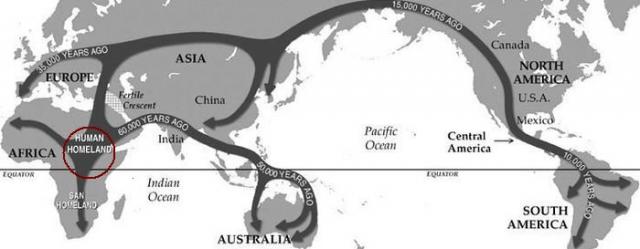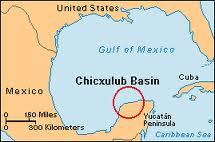Human Timeline
The Earth formed from a vast gas and dust about 4.6 billion (4,600,000,000) years ago. Single cell that gave rise to life was formed about 3.5 billion (3,500,000,000) years ago. Dinosaur appeared about 230 million years ago and was extincted of 65 million (65,000,000) years ago.
It is widely agreed that such an object 10 kilometers across struck just off the coast of the Yucatan peninsula 65 million years ago. It created 150-kilometer-wide crater. Dinosaur extinction came quickly, the impact must have spelled the cataclysmic end where dense clouds of dust blocked the sun's rays, darkening and chilling Earth to deadly levels for most plants and, in turn, many animals.
2,400,000 Years Ago (2.4 Million) - Homo Erectus (Early Man) evolves in Africa around the village of Bouri in the Middle Awash Valley, in Ethiopia, Africa (A).
1,900,000 Years Ago (1.9 Million) - Homo Habilis occupied the area around Olduvai Gorge, Tanzania, Africa (B).
250,000 Years Ago - The earliest fossil evidence for anatomically modern Homo Sapiens where found near the Omo River, Omo National Park in south-western Ethiopia, Africa (C).
200,000 Years Ago - The evidence of Homo Neanderthal (an extinct species of human) where found in Feldhofer Cave, Germany, Europe.
150,000 Years Ago - Mitochondrial Eve is a woman that lived in East Africa. She is the most recent female ancestor common to all mitochondrial lineages in humans alive today. Note that there is no evidence of any characteristic or genetic drift that significantly differentiated her from the contemporary social group she lived with at the time.
140,000 Years Ago - Y-chromosomal Adam lives in Africa. He is the
most recent common ancestor from whom all male human Y chromosomes are
descended. The Y chromosome is passed down identically from father to
son, so mutations, or point changes, in the male sex chromosome can
trace the male line back to Adam - the father of all humans.
The Mount Toba Eruption, 74,000 years ago, almost caused the extinction of the human race. It was believed that the entire world's population had drop to just a few thousands of the strongest individual.
70,000 Years Ago - Appearance of modern man in sub-Saharan African. Behavioral modernity according to the "great leap forward" theory. The theory refer to a set of traits that distinguish present day humans and their recent ancestors.
60,000 Years Ago - Homo sapiens that leave Africa in this wave start interbreeding with the Neanderthals they encounter. Genetic evidence suggests interbreeding took place in the Middle East.

The “Out of Africa” Theory
- 50,000 Years Ago - Migration to South Asia. Mutation carried by all non-African males.
- 45,000 Years Ago - Homo sapiens reached the end of South East Asia by around 45,000 years ago
- 40,000 Years Ago - Migration to Australia.
- 25,000 Years Ago - Around the time of the beginning of the Last Ice Age where extensive ice sheets lay over large parts of Europe, the independent Neanderthal lineage dies out.
Neanderthal extinction hypotheses: Neanderthals had limbs that were shorter and stockier than those of modern humans. They were not able to survive is related to the fact that they could not run as fast as modern humans, and they would require 30% more energy than modern humans would for running or walking.
- 15,000 Years Ago - Migration to America.
- 12,000 Years Ago - End of the Last Ice Age. Start of the agricultural society in the area known as Levant which includes most of modern Lebanon, Syria, Jordan, Israel, Turkey and as far east as Iraq. This is also known as the start of Mesolithic period.
- 7,000 Years Ago - Fishing, cultivating and planting rice activities started along Yangtze River in China.
Updated On: 15.02.11

